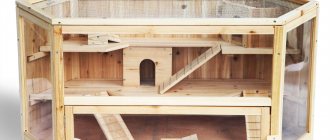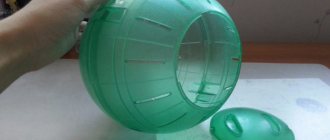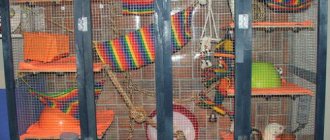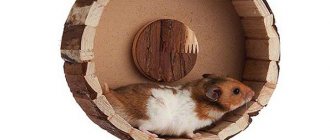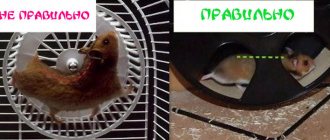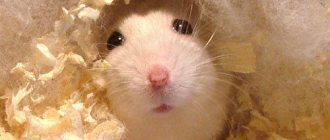- home
- Housing
03.11.2018 Toys for hamsters are essential items. The health of these restless, fussy animals is inextricably linked with physical activity. In order for your little pet to spend his leisure time beneficially “for body and soul,” you should make sure that the hamster has a sufficient number of interesting toys. Many sports and entertainment devices are presented in pet supply stores. But if their price does not fit into the owner’s budget, in order not to leave the animal without joy and a reason for training, you can make useful toys for the hamster with your own hands.
Types of running wheels for hamsters
Hamsters of different breeds can be very tiny, from 4.5 cm to large individuals reaching 34 cm in length.
Accordingly, some are lighter, others are heavier. Depending on the type of your hamster, you should select a running wheel for your pet. Which wheel you choose for your hamster’s home will depend not only on its health, but also on its safety. Agree, if you buy a small wheel for a large hamster, and a huge one for a miniature one, then your animals will not be able to run on this simulator.
So the first thing you need to do is decide on the diameter of the running wheel.
For example, for Djungarian hamsters or for a Syrian baby, the diameter of the wheel should be a minimum of 14 cm and a maximum of 16 cm.
An adult Syrian hamster needs wheels more than 18 cm in diameter.
The track in the wheel must be of sufficient width. If its width is not enough, the hamster may fly out of the wheel. For example, for miniature dwarf breeds, a width of 5 cm will be enough, but for Syrian hamsters, the width of the wheel should be at least 7 cm.
The trainer should be the size of your rodent. If you have not chosen the correct diameter of the treadmill, then your baby will squeeze, stumble and get injured in the small wheel. It's hard for kids to run in a wheel that's too big. They have difficulty rotating it and, as a result, will stop using it altogether.
Not only the comfort of your hamster, but also the health of your pet depends on a correctly selected wheel. The consequences of incorrectly purchased running wheels can be sad. Spinal injuries, dislocations of limbs and even fractures are possible.
Running wheels are:
- plastic;
- metal;
- wooden;
- combined.
One of the disadvantages of metal running wheels is that they tend to squeak over time. Considering that your animal loves a nocturnal lifestyle, it will train in its wheel at night. Your sleep and a squeaky wheel don't go well together, would you agree?
The plastic running wheel is quiet and comfortable enough for a hamster to run. The main thing is that the treadmill has small ribs that the little athlete can cling to and not slip off.
Running wheels made from a combination of plastic and metal materials have proven themselves. The wheel itself is made of plastic, and the stand is metal. This is a silent and lightweight design with a reliable metal support.
Basically, lattice, mesh and wooden running toys for hamsters are common. If the wheel has a metal mesh, then the cells should be small so that the furry paws do not fall into them.
Important! The gap between the rotating working part of the surface of the simulator and the fastening of the wheel stand axle must be more than one centimeter. Otherwise, the hamster risks cutting off its leg, as the limb may get stuck in a narrow space, in which case the “scissors effect” is obtained.
The only negative is that from time to time the hamster can sharpen its teeth on its treadmill, but this will not cause any harm to its health.
Methods for attaching running wheels
- Hinged - screwed with special fasteners or ordinary wire to the cage lattice. This option is suitable for small cells. During hamster training, there may be sounds of the wheel tapping on the mesh of your pet's home.
- Floor-standing - these wheels stand on a floor stand and fit well into a spacious cage. The main disadvantage is that they are not entirely stable.
- On a stand with floor mounting - this method of mounting is more reliable. The stand attaches securely to the cage floor. This is the safest simulator.
Cardboard and paper toys
Toys made of cardboard and paper have a number of advantages:
- Easy to manufacture.
- Relatively safe.
- Interchangeable.
There is only one minus - they are short-lived. In addition, the paper “holds” the smell well. If the hamster is in heat or tends to mark territory, paper accessories can become a source of unpleasant odor.
When making paper toys or a house, you will have to use glue. When choosing glue, pay attention to the labeling; it must be non-toxic and safe.
Tip: Use water-based PVA glue, it is non-toxic and will not lead to serious consequences, even if the hamster completely eats the toy.
Obstacle course
Obstacle course is a very interesting and easy to make game for a hamster. The point of the game is that the pet must follow a certain path and receive a reward. The obstacle course is usually a labyrinth made from available materials.
Where is the best place to place a hammock in a cage?
In order for the hamster to show interest and actively use the hammock for its intended purpose, it must be hung correctly in the rodent’s home. It is useful to consider the following points:
- Optimal height: the pet should easily climb into the hammock and get out of it without the risk of injury. A cradle located near the floor will often get dirty and interfere with the hamster's ability to move around the cage. Therefore, it is recommended to hang the product at a height of 5–10 cm from the bottom of the cage.
- Hammocks for hamsters should be placed where the animal likes to rest. The location should not coincide with the feeding or toilet area. It is best to place the bed on the second level of the home.
- The fastenings for the hammock are chosen to be reliable and durable: the bed should not move or turn inside out. The clamps must be universal and secure the product in any part of the cage.
- The owner should be able to easily remove the cradle if it needs to be washed or repaired.
You can make many accessories for a hamster with your own hands. A hanging bed in this regard is no exception. It will not only bring great benefits to the pet, but will also create comfort and decorate the house.
Ideas on how to make a comfortable house for a hamster - diagrams, drawings and instructions
From plastic bottles
Option 1. To make a shelter for an animal from plastic bottles, you need 2 clean bottles of 1-1.5 liters, electrical tape, scissors and a stationery knife.
The neck and bottom of both containers are cut off, and the cut points are treated with electrical tape to prevent the occupant from being injured in the future. A hole is cut in one of the bottles exactly in the middle, equal to the diameter of the second.
The second container is inserted into the finished cutout of the first container; it should fit tightly. The resulting structure is secured with electrical tape.
Option 2. Such a house can replace a cage and will be like an aquarium with several compartments.
Several clean bottles with a volume of 5 or more liters are required. Each of the containers will represent a so-called room, so the number of containers used is limited only by the imagination of the master. You will also need a utility knife and scissors.
- The tops of the bottles are cut off. The height of future rooms should be such that the pet cannot climb over it and get lost in the bowels of the apartment.
- The necks are cut off from the remaining upper part of the bottles so that they look like funnels. You won't need caps for them.
- In the lower part of the container, almost at the very bottom, holes are cut, equal in diameter to the necks.
- All rooms are connected to each other through funnel necks.
In the video you can see what such an apartment looks like.
Does your pet live in a house made of natural materials? Poll Options are limited because JavaScript is disabled in your browser.
From cardboard
For construction you will need the most ordinary boxes of ready-made breakfasts or juice, scissors and a stationery knife.
All you have to do is cut the box to size and cut out the entrance.
If you use toilet paper rolls or paper napkins for construction, you will get an excellent labyrinth that rodents love so much. But you should take into account the size of the hamsters; for large individuals this type of entertainment is unacceptable.
From a box of paper napkins
For a simple construction, you will need one cardboard tissue box, stationery glue and a toilet paper or paper napkin roll.
It is necessary to remove all plastic elements and film from the future home. It is better to give preference to square-shaped containers; they can be cut exactly in the middle and you will get two ready-made houses that already have an entrance for the animal.
A toilet paper roll makes a great addition to your shelter. It is enough to glue it into the passage and it will be an imitation of a mink, which will obviously please the rodent.
From a plastic container
This type of container can be found in almost any home or purchased for a small amount in a store.
For construction you will need a food grade plastic container and a soldering iron.
- Using a heated soldering iron, the entrance to the house is cut out, and holes are made on the lid of the container for ventilation. This will help the pet feel comfortable in the home.
- Sawdust or any other bedding is laid out at the bottom of the house.
The advantage of such a structure is that it is convenient to wash, and it will also last longer than cardboard.
Wooden house
For construction you need:
- wooden board 1-4 cm thick;
- ruler;
- a simple pencil;
- circular saw or jigsaw;
- sandpaper;
- hammer;
- small nails.
Two parts 12.5 cm long and two parts 14.5 cm long are cut out and polished from the board. The height is taken arbitrarily, but it must be calculated so that the hamster can move freely.
A hole with a diameter of 6 cm is drilled (cut) in one of the 12.5 cm long blanks. Several small windows are made in different walls of the house for better ventilation. All cut holes are ground.
All parts are assembled using nails. You can use a square wooden sheet for the roof.
Mitten house
During the cold period, any living creature likes to bask where it is warm. Rodents are no exception.
During severe cold weather, it is enough to put a mitten that no one needs anymore in the cage. The hamster will instantly find a use for it and build his nest in it.
The downside of such a house is that it will most likely quickly acquire an unpleasant odor and wear out. Whether to replace it with a new one or not is up to the breeder to decide.
Coconut house
Due to its size, this type of housing is suitable only for Djungarian hamsters.
You will need:
- coconut;
- knife;
- hacksaw;
- sandpaper.
First, you need to drain the milk from the coconut by making holes in the eyes. Having stepped a couple of centimeters away from them, you need to tap with the handle of a knife; if a crack appears on the shell, then this part of the fruit is cut off with a knife, if not, then you should use a hacksaw. The pulp is completely cleaned. The cut edge is sanded with sandpaper.
Delicious "walnut" staircase
From the empty shells of several walnuts you can make an excellent toy for your pet. In addition to the empty shell halves, you need to prepare in advance:
- a thin nail with a sharp end;
- hammer;
- a strong thread as long as the height of the cell;
- medium size washer.
In all prepared half-shells, you need to carefully make a hole in the center. This is done by driving a nail (there is no need to leave it in the resulting hole). You need to thread a thread through the holes to make the shells into a kind of beads. An important nuance - all halves must be turned in one direction, with the exception of the last one. In a vertical position, the beads look like a stack of bowls standing on a tubercle.
A washer is tied to the end of the thread coming out of the last (lower) shell so that the thread is securely fastened and the structure does not fall apart. The upper end of the thread is tied to the “ceiling” of the cage so that the lower shell lies on the bottom, but the “beads” do not sag. You need to put treats for the hamster in all the resulting bowls. Climbing the structure, the pet will take away a tasty prize at each stage of “conquering the peak”.
The height of the structure must be respected. Hamsters climb beautifully, but they descend simply by jumping. Therefore, you should not use shells from more than several nuts for one construction. In addition, it is important to provide your pet with a soft landing - the bedding in the area of the toy should be thick.
Toy options for hamsters
With the appearance of a small rodent in the house, owners begin to be interested in a lot of completely new questions for them. Is it possible to bathe a hamster? Should you give your rodent meat? What toys does a hamster need? Regarding the latter, we have prepared a small list of possible options. It can be:
- Stairs.
- Swing.
- Houses.
- Labyrinths.
You can get acquainted with a wide range of products at any pet store. As a rule, there is quite a large selection there. But the cost of toys is not always affordable for buyers. However, this is not a reason to deny your pet toys. You can...make them yourself. And we will tell you how to do it correctly and quickly.
Making simple tunnels
A hamster cage must contain at least one small tunnel. And for games outside the home, complex structures of medium and large size are suitable. You can make a permanent entertainment room for your furry friend or build the attraction anew each time, changing its size and direction of moves.
Children are showing great interest in creating entertainment for hamsters. We invite you to study the instructions for creating simple tunnels that even a schoolchild will understand.
Paper tube for cage
The simplest option is to use a cardboard paper towel tube as a building material. You can put it in the cage unchanged or make windows in the tube so that the animal can come out through them.
The sleeve tube can also be installed in external cardboard labyrinths.
Game room
Do your kids love to play with and watch hamsters? Then give them an idea: make a tunnel for a hamster from an unnecessary cardboard box. The kids will happily get down to business, use their creative imagination and create an attraction with love.
There are a lot of construction options. We will tell you how to make a hamster maze in two different ways.
- The first method does not involve the use of glue. Take a box and pieces of cardboard: 3 strips should correspond in size to the length of the room, 5 to the width. On long pieces, make 5 cuts at equal distances from each other, and cut short pieces three times. Between the cuts, cut out doors, windows and holes for pipes. Now we can assemble our room. Install long partitions with the cuts up, and insert short parts into them with the cut down. You will get a lattice. If you have pipes planned, insert them into the round cutouts. Place the grid in the box and you can start playing right away!
- The second method is based on gluing the walls. It is good because you can create a variety of branches, as well as a rest room for a small creature. To glue the walls, use regular or construction tape.
Labyrinth from a construction set
Preschoolers and schoolchildren love to build various castles and fortresses from construction sets. Invite them to make an attraction for a hamster - they will happily complete this task. Moreover, children themselves know how to make a labyrinth for a hamster from Lego constructors interesting and convenient.
If you are building a walker for a dzhungarik, small parts are better suited. For the larger Syrian breed, use medium sized pieces. Using a small construction set inside the maze, you can build a small obstacle course for the animal, at the end of which you can place a tasty nut.
Book fortress
Old hardcover books are suitable for creating a large, spacious tunnel. To do this, they need to be placed with their roots facing up. It is better to completely enclose the space with books so that the hamsters do not run away in different directions. For one animal, the width of the passage can be 5-8 cm (so that the animal can easily turn around in it), but if you have several fluffies, the tunnels should be more spacious.
In such a book fortress, kids really love to have hamster races. Rodents are placed in a common closed room, after which they open the “door” and watch which of the animals gets to the exit first
At the same time, it is important to ensure that race participants do not violate the rules. If a cunning hamster climbs over the wall, he must be brought back. A maze made from books can also be used to train animals.
To do this, you need to place small pieces of tasty food along the chosen path, and repeat the operation several times with the same route. Then you should place the treat only at the exit. You will be surprised how quickly your smart hamster will find it!
A maze made from books can also be used to train animals. To do this, you need to place small pieces of tasty food along the chosen path, and repeat the operation several times with the same route. Then you should place the treat only at the exit. You will be surprised how quickly your smart hamster will find it!
Tunnel made of plumbing parts
If your apartment has recently been renovated and you still have unnecessary parts for connecting pipes, use them to create a branched labyrinth! This attraction is suitable for both small Djungarian and larger Syrian and Caucasian hamsters. By the way, the tunnel made from plumbing looks very original. Another advantage is the collapsible design of the attraction, which means you can periodically change the direction of the moves.
Making it is very simple: connect the parts in any direction. It will be more interesting for the hamster to play if there are several exits in the pipe. But in this case, do not leave the home unattended, otherwise you will have to look for it throughout the apartment!
Playground
The animal's play area can be organized outside the cage. To do this, fence off an area of the room with cardboard boxes, connecting them with tape. Be sure to check the reliability of the design so that you don’t have to catch your baby throughout the apartment.
On the playground, place various toys and any household items that are safe for the animal. Observe the animal, which toys it likes best. Equip the playground with ladders, a wheel, bridges, a sandbox, a rope and flower pots and children's toys. Some of them can then be transferred to the cage.
Step-by-step instructions: how to make a labyrinth?
From plastic bottles
Now we’ll learn how to make a maze for a hamster with your own hands from plastic bottles. As it turns out, they can be used to make a whole gallery of multi-level tunnels. The configuration of the labyrinth can be simple, or with dead ends, and even multi-level. For the simplest play structure with 2 knees you will need 3 plastic bottles. Conventionally, they can be designated as:
- Entrance corridor.
- Passage corridor.
- Dead end.
You need to wash the bottles and remove the stickers from them. Cut off the bottom of the inlet bottle. Through this hole the hamster will enter the maze from his cage. The cut line should be free of notches and burrs. Cover the cut with electrical tape or tape so that the sharp edges do not injure the nimble animal.
In the part of the bottle where the narrowing towards the neck begins, 2 holes are cut out opposite each other with scissors: a small hole with a diameter slightly larger than the cap and a large one, almost equal to the diameter of the bottle. To cut a circle, first use a knife to make a cross-shaped slot into which you can easily insert scissors.
In the tapering part of the second - passage - bottle, make a round hole smaller than the diameter of the bottle. Cover the edges of all cuts with tape or tape.
Insert a pass-through bottle through the large hole so that the cap comes out the other side. The parts should form the letter “G” or, in other words, a knee. In the same way, neck to neck, attach the third bottle - a dead end.
If you want your hamster to have a treat at the end of the maze, make a hole at the top of the dead end where you can insert a funnel and pour treats through it for your pet. A homemade funnel can be the cut off neck of a bottle with the cap unscrewed. The connections of the parts are firmly fixed with tape.
Made of wood and plywood
A portable labyrinth is constructed from wood and plywood. For this you will need:
- Planks.
- Plywood.
- Glue.
- Wood saw.
The base can be cut out of plywood. If a plastic box is chosen as the basis for the labyrinth, then it is better to sprinkle the bottom of the labyrinth with sawdust or sand so that the animal does not slip. The height of the walls of the base should be sufficient to prevent the hamster from climbing outside.
- Make the base of the labyrinth - the floor and outer walls.
- Place the boards inside so that they form an intricate labyrinth.
- Cut holes in some walls for a through passage.
- Glue the planks to the floor and base walls with glue.
- Make some of the galleries covered - rodents love dark holes.
- Allow the structure to dry from the glue.
From cardboard
The labyrinth is made from cardboard in the same way as from planks. The parts of the product are cut out with scissors and attached to the base with tape.
Shoe boxes, toothpaste boxes, etc. are used to make interior walls. Place them inside a large base, cut random passages of an interesting configuration in the walls. Glue with glue or tape.
From toilet paper rolls or paper towels
Rolls of toilet paper and paper towels make interesting tunnels. Such tunnels are located between boxes inside the structure, making it more similar to a hamster's home in a natural environment. Paper sleeves are attached with tape or glue.
From a children's construction set
You can make a labyrinth of any complexity using a children's construction set. Build a playground with bridges, galleries and obstacles. Add a staircase and a second floor. Don't forget to design a compartment where your pet will have a treat.
From plumbing pipes
Plumbing pipes can be used both as separate tunnels inside the box and as material for the manufacture of an entire structure. This is a durable material that even has factory connections - fittings. Make a structure of any complexity from pipes. Make small holes for ventilation in the product.
Therefore, ventilation can be made in the form of longitudinal slits or a series of small holes in the pipes. This way you will have windows for observing the little traveler.
A ready-made hamster cage with a labyrinth will save you from the need to regularly walk your pet. Such products are sold in stores, or equip the cage yourself with a tunnel made of durable material. Please note that a hamster is capable of chewing even the most durable plastic of factory products. Therefore, regularly check the integrity of the structure.
How to monitor the health of hamsters?
Your pet will occasionally need to visit a veterinarian; choose a veterinarian who has experience working with rodents. You should visit your veterinarian a few days after your hamster comes into your home, and then every year. You should contact a specialist if your hamster has a runny nose or wheezing, if he eats or drinks irregularly, if his teeth have grown too long, if he has bald patches, or if he has ulcers on his paws. You should also contact a veterinarian if there is blood in the urine, itching or loose stools.
How to make a ball for a hamster from bottles with your own hands
If you don’t want to waste money trying to determine whether your hamster will like the walking sphere or not, you can make it yourself. This will require just a few available materials, perseverance and a little resourcefulness.
Let us further analyze the main stages of manufacturing a device for walking domestic rodents.
What you need
In order to make a walking ball for a hamster, you do not need specialized materials or expensive tools. It is enough just to look around or, as a last resort, visit the nearest supermarket.
DIY walking ball for hamsters: video
So, for these purposes we need the following:
any round container with a tight lid and sufficient diameter (for dwarf hamsters, etc. about 12 cm, for larger species about 18 cm, for the largest hamsters about 30 cm)
Its role can be played by plastic containers for dairy products or other goods, and it is important that the diameter of the lid allows the rodent to freely penetrate inside the container; an awl, stationery or sharp kitchen knife; sandpaper P150 or P180;
detergent.
Important! It is not recommended to use containers containing toxic or flammable materials for the manufacture of walking spheres, as they can cause severe poisoning of the rodent.
Self-production
Once you have acquired all the necessary materials and tools, you can begin creating your first walking ball for your beloved hamster. Making the device does not require any special skills, so even children can trust it, or turn it into an exciting family adventure.
The process consists of the following steps:
- Remove all stickers from the container and clean its outer surface of any glue residue.
- Wash the container thoroughly with detergent and dry naturally;
- Make ventilation holes in the vessel. To do this, use an awl to create the maximum number of small holes, or use a sharp knife to make several small oblong holes measuring 0.3 cm x 4 cm.
- Sand any sharp edges of the holes using sandpaper.
Your ball is ready, now you can happily use it to walk your pet hamster. By following all of the above recommendations, in just a few minutes you will be able to create a durable and reliable structure that will delight your pet for many months.
A walking ball is one of the few truly important accessories for keeping a pet rodent. After all, the device makes it possible for the animal to maintain the necessary athletic shape, as well as tone its body.
However, when choosing one, it is necessary to determine the correct size, since only in this case will the hamster walk in the ball be as safe as possible for its health.
Crafts from matches and ice cream sticks
Crafts from matches and ice cream sticks are one of the simplest options for making toys. Before making, you must wash the sticks thoroughly. If you use matches, use sharp scissors to remove the sulfur heads.
From sticks or matches you can make:
- Bridge.
- Manhole or ladder.
- Shelters of any shape.
Sticks and matches must be fixed with glue. If the frame is wooden, PVA wood glue will do. If the frame is made of wire or plastic, the sticks can be secured with a glue gun.
What toys does a hamster need?
Before you start making attractions, it is important to examine the animal’s apartments and figure out where and what kind of toy is best to attach. When the division of free territory is over, we decide on the necessary entertainment complexes
Without a doubt, first of all, the furry furry’s living space should be equipped with a house. Do not forget that the hamster is a nocturnal animal. The presence of a kennel will allow the animal to hide from sunlight, and nothing will disturb its sleep.
The next point worth noting are toys designed for grinding teeth. Rodents are happy to chew anything that comes their way
To prevent the cage from wearing out prematurely, thanks to its furry assistant, it is important to equip the hamster’s territory with sticks and branches of fruit trees. This way the animal will have something to chew, and the bars of the cage will not arouse much interest.
Don't forget about running gear. Ladders, balls for walking around the house, wheels - exactly what you need. And intricate tunnels and passages with obstacles will help to further diversify your furry baby’s leisure time. Whatever your imagination comes up with won't hurt.
Useful video
Do you want your hamster to remain cheerful and agile? Do you want him to never get bored? Do you want to provide him with every opportunity for physical and mental activity? Like the one that wild hamsters get during their nocturnal adventures?
Then it is necessary to provide your pet with interesting activities, both in the cage and outside it - on the playground.
Go to a pet store and browse the sections that sell hamster supplies. You will see a wide variety of toys and entertainment equipment. You'll find wooden molds with holes for the Syrian hamster, grass and bamboo balls and grass tunnels for the hamster to hide in and chew on, as well as colorful cars, shoes, trucks and planes for the hamster to climb on or crawl inside. The question arises: with such wealth, how can you choose what your hamster will like? Will your golden hamster climb stairs or swing on a swing, will it go into a prefab or grass tunnel, a rocket or an airplane? Unfortunately, it is impossible to predict for sure which toys he will like and which he will not. But fortunately, toys for hamsters are usually not very expensive, so a toy rejected by your pet won't cause much damage to your budget.
Please note that all animals are very different. For example, Goldn likes variety in her life and can very quickly lose interest in a toy that she has already explored hundreds of times. Even the best toys can become boring if played with for too long. (Isn’t it like that with us?) Therefore, constantly offer new toys to your pet, put away the old ones and after a while put them back. Or combine and rearrange old toys to give them a new twist. That is, do whatever you want to make life interesting for your hamster.
And don't forget to inspect your toys regularly. Check to see if they have become unusable or chewed. Don't be sorry, throw away any overly chewed toys if you think they are unsafe for your hamster's health.
Spin, spin, wheel.
The first thing you will notice on the shelves of a pet store is the abundance of hamster wheels. Almost all hamsters enjoy running on a wheel; no training is required. Revisiting the “Wheel Activity” in Chapter 5 will help you decide on the right wheel and help you remember information about how to use them and the problems that arise.
Tubes and tunnels
Please note that there cannot be too many tubes and tunnels. After all, in the wild, hamsters spend their days hiding and sleeping in a labyrinth of underground tunnels. So if you don't have a cage system with connecting tubes, it might be a good idea to build an obstacle course on your playground. Attach straight and right-angled plastic tubes to spigots, tees and six-hole cubes to create an interesting labyrinth. Fortunately, you don’t need to purchase everything at once; you can build such a labyrinth, piece by piece. And to keep Goldn always interesting, rearrange the sections more often, creating new configurations.
How to care for a hamster
In general, hamsters have special care needs. They need to be cleaned with a brush. If the hamster is long-haired, this breed is often called a teddy bear, then every week you need to comb its fur in order to remove food debris, shavings, and dirt, which gets very stuck in the animal’s fur. You can use a specialized comb designed for small animals, a toothbrush that should be soft.
Most hamsters generally do not need to have their nails trimmed, however, if your hamster itches while grooming itself or your hamster's claws begin to curl, you should contact your veterinarian.
Be sure to check your hamster's mouth. He should always have healthy teeth, as they are constantly growing. You need to constantly give your hamster chewing sticks and toys to help him wear down his teeth. If the teeth grow too long, if chips or other damage appears, then you need to contact a veterinarian.
Some hamsters need to take care of their skin; if the animal is naked, then you need to rub coconut or baby oil into its skin, which will not have an odor. This is necessary so that the skin does not dry out and is also healthy.
Sometimes let your hamster play outside the cage, this way he will get the necessary exercise and also be able to socialize with you. Be sure to fence off the area in order to run freely. Give him toys and interact with him. However, always keep an eye on your pet.
Remember that hamsters must be handled very carefully. Hamsters need to be picked up with both hands and also held in cupped palms. Make sure that the hamster does not slip out of your hands.
Hamster toys
Hamsters in nature are forced to spend a lot of time searching for food and fleeing from predators. They don't have time for special games. In captivity, animals often become overweight due to their conditions: small cages and insufficient equipment.
Therefore, in order to create ideal conditions for animals, it is necessary to properly equip the cage and fill their leisure time with special devices. Since it is unwise to put hamsters in danger by having a predator, toys should work in two directions:
- searching for food;
- physical activity.
For the first, grass balls in which a treat is buried, various types of sandboxes and structures with seeds inside are suitable.
What to feed hamsters?
Pellet food is the best choice and is an excellent choice for keeping your hamsters nourished. Due to the fact that such food is supplied in the form of granules, the animal cannot choose only the most delicious food. This food is capable of delivering a large number of different nutrients to the hamsters’ body. You need to feed your hamster about once a day, with the bowl three-quarters full. In addition, you can give your hamster a variety of vegetables, they should be given every other day. From vegetables, hamsters can be given pumpkin, a variety of greens, peppers, grated carrots and zucchini, broccoli, apples and cucumbers, pears, and a variety of berries. The hamster should be given as much food as he can eat in four hours. Hamsters should not be overfed as they love to hoard food. Hamsters should have constant access to clean water; it is best to install a specialized drinking bowl with a glass spout.
